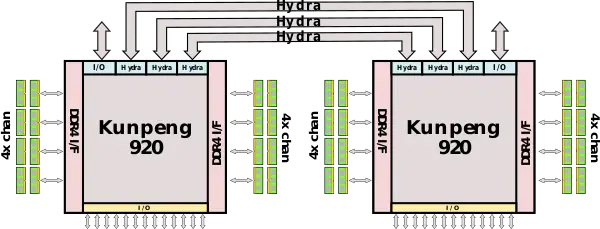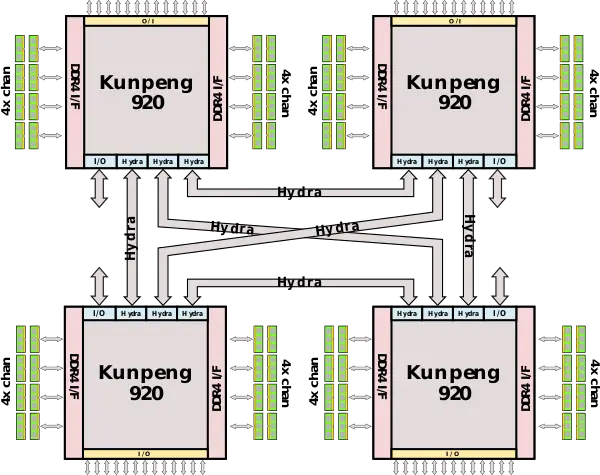From WikiChip
Difference between revisions of "hisilicon/microarchitectures/taishan v110"
| Line 28: | Line 28: | ||
|l3=1 MiB | |l3=1 MiB | ||
|l3 per=core | |l3 per=core | ||
| − | | | + | |predecessor=TaiShan v100 |
| + | |predecessor link=hisilicon/microarchitectures/taishan_v100 | ||
}} | }} | ||
'''TaiShan v110''' is the successor to the {{\\|TaiShan v100}}, a high-performance [[ARM]] server microarchitecture designed by [[HiSilicon]] for [[Huawei]]'s own TaiShan servers. | '''TaiShan v110''' is the successor to the {{\\|TaiShan v100}}, a high-performance [[ARM]] server microarchitecture designed by [[HiSilicon]] for [[Huawei]]'s own TaiShan servers. | ||
Revision as of 01:48, 3 May 2019
| Edit Values | |
| TaiShan v110 µarch | |
| General Info | |
| Arch Type | CPU |
| Designer | HiSilicon |
| Manufacturer | TSMC |
| Introduction | 2019 |
| Process | 7 nm |
| Core Configs | 32, 48, 64 |
| Pipeline | |
| Type | Superscalar, Superpipeline |
| OoOE | Yes |
| Speculative | Yes |
| Reg Renaming | Yes |
| Decode | 4-way |
| Instructions | |
| ISA | ARMv8.2-A |
| Extensions | NEON |
| Cache | |
| L1I Cache | 64 KiB/core |
| L1D Cache | 64 KiB/core |
| L2 Cache | 512 KiB/core |
| L3 Cache | 1 MiB/core |
| Succession | |
TaiShan v110 is the successor to the TaiShan v100, a high-performance ARM server microarchitecture designed by HiSilicon for Huawei's own TaiShan servers.
Contents
Brands
TaiShan-based CPUs are branded as the Kunpeng 920 series.
Release Dates
Kunpeng 920 CPUs were officially launched in early 2019.
Architecture
This list is incomplete; you can help by expanding it.
Block Diagram
Entire Chip
Memory Hierarchy
- Cache
- L1I Cache
- 64 KiB/core, private
- L1D Cache
- 64 KiB/core, private
- L2 Cache
- 512 KiB/core, private
- L3 Cache
- 1 MiB/core
- Shared by all cores
- System DRAM
- 1 TiB Max Memory / socket
- 8 Channels
- DDR4, up to 2933 MT/s
- 1 DPC and 2 DPC support
- 8 B/cycle/channel (@ memory clock)
- ECC, SDDC, DDDC
- L1I Cache
Overview
| This section is empty; you can help add the missing info by editing this page. |
Core
| This section is empty; you can help add the missing info by editing this page. |
Scalability
There are three cache coherent ports on each SoC. Every port supports 240 Gb/s (30 GB/s) of peak bandwidth for a total aggregated bandwidth of 720 Gb/s (90 GB/s) in a 2-way symmetric multiprocessing configuration.
With all three links, there is also support for 4-way SMP. In this configuration, one link from each socket is connected to another socket for an all-for-all connection.
Die
- TSMC 7 nm HPC
- 20,000,000,000 transistors
All TaiShan Chips
| This section is empty; you can help add the missing info by editing this page. |
Bibliography
- Huawei. Personal Communication. 2019
- Huawei Connect 2018. October 2018
- HiSilicon Event. January 7, 2019
Facts about "TaiShan v110 - Microarchitectures - HiSilicon"
| codename | TaiShan v110 + |
| core count | 32 +, 48 + and 64 + |
| designer | HiSilicon + |
| first launched | 2019 + |
| full page name | hisilicon/microarchitectures/taishan v110 + |
| instance of | microarchitecture + |
| instruction set architecture | ARMv8.2-A + |
| manufacturer | TSMC + |
| microarchitecture type | CPU + |
| name | TaiShan v110 + |
| process | 7 nm (0.007 μm, 7.0e-6 mm) + |

